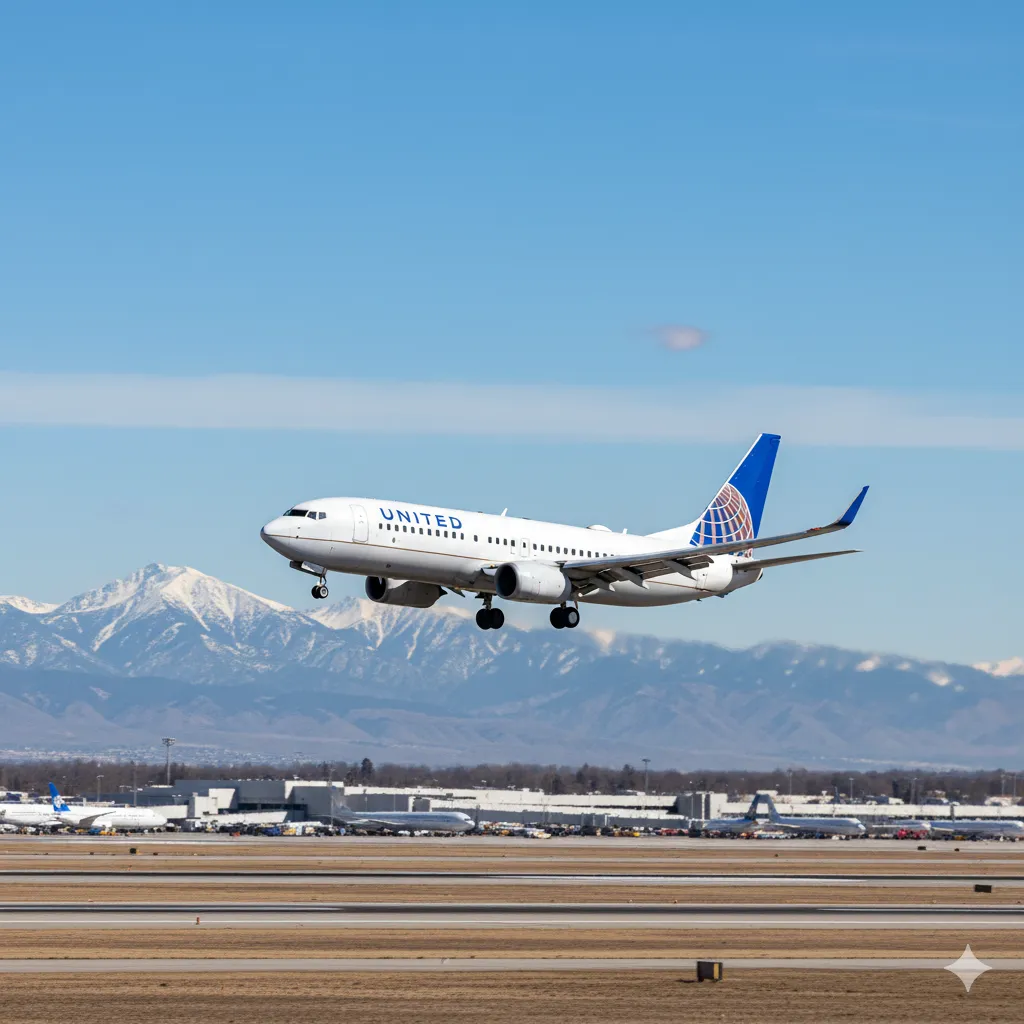United Airlines Flight UA770 Emergency Diversion – Full 2025 Incident Report

Introduction: A Routine Flight Turns Unexpected
On July 28, 2025, passengers aboard United Airlines Flight UA770 found themselves in an unexpected situation when their cross-country flight from San Francisco to Chicago was diverted mid-air. What began as a routine morning journey quickly became a powerful example of aviation professionalism, preparedness, and the unshakable priority of safety.
The United Airlines Flight UA770 emergency diversion not only reassured the public about the reliability of modern aviation but also shed light on how airlines respond to sudden system warnings thousands of feet above the ground.
Incident Overview: Flight UA770’s Sudden Turn Toward Denver
United Flight UA770, operated by a Boeing 737-900, departed San Francisco International Airport (SFO) at approximately 7:30 AM local time. It was expected to reach Chicago O’Hare International Airport (ORD) just before noon.
However, roughly 90 minutes into the flight, while cruising at around 34,000 feet, the cockpit received a warning light associated with the aircraft’s hydraulic system. Although this did not indicate immediate failure, hydraulic issues are among the most sensitive in aviation, influencing vital systems such as:
- Landing gear deployment
- Flap control
- Brake pressure and steering
In line with United’s strict safety procedures, the pilots made the decision to divert to Denver International Airport (DEN) — a nearby hub equipped with advanced maintenance facilities and emergency response infrastructure.
Why Denver Was Chosen as the Diversion Point
When emergencies occur mid-flight, the nearest airport isn’t always the best or safest option. The choice to divert to Denver reflected three key considerations:
- Proximity and Preparedness: Denver International Airport was within approximately 45 minutes of flying time, allowing for a controlled descent and safe landing.
- Maintenance Resources: As a major United Airlines operational base, Denver offers on-site technical teams and access to spare parts necessary for hydraulic inspection and repair.
- Passenger Support Infrastructure: Denver’s size and connectivity allowed for efficient passenger rebooking, accommodation, and support services once the aircraft landed.
This combination made Denver the logical and safest diversion airport for Flight UA770’s situation.
What Triggered the Emergency Diversion
United Airlines later confirmed that the diversion was initiated after the crew received a hydraulic system warning alert.
Hydraulic systems in aircraft are powered by fluid pressure and are crucial for flight control, landing gear, and braking. Even a minor fluctuation or leak can have cascading effects if ignored.
Key Factors Behind the Decision
- Potential for system degradation if the issue worsened during flight.
- High safety margin protocol — any warning involving hydraulics is treated as an immediate priority.
- Weather and terrain considerations, with Denver providing optimal landing conditions.
Aviation analysts agree that declaring an emergency in this scenario was the correct decision — ensuring maximum safety margin even if the alert turned out to be precautionary.
Crew Response: Calm, Clear, and Commanding
One of the most remarkable aspects of the United Airlines Flight UA770 emergency diversion was the crew’s professionalism and poise.
Within minutes of detecting the warning, the captain informed passengers of the situation, explaining that the aircraft would divert to Denver “out of an abundance of caution.”
Flight attendants executed their training with precision — ensuring that:
- Seat belts were secured.
- Overhead bins remained closed.
- The cabin remained calm and orderly.
Passengers later reported that the tone inside the aircraft was surprisingly calm. One traveler posted on X (formerly Twitter):
“Shoutout to the #UA770 crew. Calm, clear communication from start to finish. Unexpected landing in Denver, but everyone felt safe and informed.”
This communication strategy — transparent, confident, and consistent — is a cornerstone of aviation crisis management and a key reason for the incident’s safe resolution.
Passenger Experience During the Diversion
Passengers described the experience as a mix of nervous anticipation and relief once the aircraft touched down safely in Denver.
Some key observations from travelers included:
- Clear and timely updates from the cockpit.
- Friendly assistance from flight attendants, especially for elderly and anxious passengers.
- Smooth landing and efficient disembarkation.
Upon landing, United Airlines personnel were ready on the ground with food vouchers, rebooking options, and updates.
For most travelers, the total delay was between 3 to 5 hours, as United arranged connecting flights to Chicago or alternative destinations the same day.
United Airlines’ Official Statement
Shortly after the aircraft’s safe arrival, United Airlines issued a statement confirming the diversion:
“United Flight 770 from San Francisco to Chicago diverted to Denver out of an abundance of caution following a potential mechanical warning. The aircraft landed safely, and all passengers deplaned normally. Our maintenance team is conducting a full inspection before returning the aircraft to service.”
This swift public communication reinforced transparency and prevented misinformation from circulating online.
How Emergency Diversions Work
An emergency diversion is a standard aviation safety measure designed to manage potential risks efficiently. Airlines follow a defined decision-making process involving both flight crew and air traffic control (ATC).
The Typical Process Includes:
- Detection: A warning light, system alert, or medical emergency is identified.
- Diagnosis: Pilots cross-check indicators and consult the Quick Reference Handbook (QRH) — a detailed emergency procedure manual.
- Communication: The flight deck contacts ATC to declare a “PAN-PAN” (precautionary) or “MAYDAY” (critical) situation.
- Decision: The flight diverts to the nearest suitable airport.
- Coordination: Ground teams prepare emergency services, maintenance crews, and passenger assistance.
Such systems are the reason why air travel remains the safest mode of transportation in the world — with redundancies and trained personnel ready for any contingency.
Aviation Experts Weigh In
Aviation analysts praised the UA770 crew’s decision-making and communication strategy, emphasizing that no airline takes diversions lightly.
According to Aviation Safety Network analyst Thomas McKenzie:
“What we saw on Flight UA770 is textbook crisis management. A quick, precautionary decision prevented risk escalation. This is precisely how aviation safety protocols are supposed to work.”
Experts also highlighted the importance of proactive maintenance programs and real-time data analysis, both of which help airlines detect potential mechanical issues before they become critical.
FAA and Maintenance Response
The Federal Aviation Administration (FAA) announced a standard post-incident review. While no major safety breach occurred, FAA officials confirmed they would examine the following:
- The aircraft’s hydraulic system performance data.
- Maintenance logs from recent inspections.
- The crew’s response timeline and adherence to safety protocols.
United Airlines’ engineering team also performed a complete hydraulic system inspection on the diverted aircraft in Denver. Preliminary findings suggested that the warning indicator was likely caused by a sensor irregularity rather than an actual fluid pressure loss.
Still, the airline chose to keep the aircraft grounded until multiple test flights confirmed full system functionality.
Emergency Diversions: Lessons for Passengers
For most passengers, hearing the words “emergency diversion” can trigger anxiety. However, understanding what it really means helps ease fear.
Key Takeaways for Travelers:
- Diversions are preventive, not panic-based. They’re often called before a problem escalates.
- Crews train regularly for such scenarios — sometimes monthly in simulators.
- Modern jets have multiple redundant systems to maintain control even with partial failures.
- Passengers should remain calm, follow crew instructions, and trust the process.
In short, an emergency diversion means the system is working exactly as designed — prioritizing human life above everything else.
The Human Side of Flight UA770
For the passengers of United Flight UA770, the day became a story of gratitude and perspective. Many shared posts thanking the crew, noting how professionalism turned a stressful event into a moment of appreciation for air safety.
Parents traveling with children praised the calm demeanor of flight attendants, while frequent flyers highlighted how well United handled rebookings and hospitality.
Even though the hydraulic issue turned out to be minor, the incident reinforced public confidence in the aviation industry’s safety-first mindset.
The Financial and Operational Impact
While no airline welcomes diversions, the financial implications are relatively small compared to the safety benefits.
Estimated Costs for United Airlines
| Category | Approximate Cost (USD) |
|---|---|
| Extra Fuel Burn | $25,000 |
| Landing & Handling Fees (Denver) | $8,000 |
| Passenger Reaccommodation & Meals | $15,000 |
| Maintenance & Inspections | $40,000 |
| Crew Overtime & Scheduling Adjustments | $12,000 |
| Total Estimated Cost | ~$100,000 |
Compared to the potential risks of continuing to fly, this is a small price to pay for safety.
Public Reaction and Media Coverage
The media coverage around the United Airlines Flight UA770 diversion was largely positive, emphasizing safety, professionalism, and successful crisis management.
News outlets praised the swift crew actions and transparent airline communication, contrasting the incident with older cases where delayed updates caused confusion.
Passengers’ social media testimonials further strengthened United’s brand image, highlighting how human-centered communication builds trust even during disruptions.
Lessons and Broader Implications
The incident offers valuable insights for both the aviation industry and the traveling public.
For Airlines:
- Continue investing in predictive maintenance technologies that detect irregularities before takeoff.
- Maintain crew readiness through regular simulator training.
- Prioritize clear, empathetic passenger communication.
For Passengers:
- Understand that emergency diversions are part of aviation’s built-in safety net.
- Stay calm and cooperative during announcements or unexpected landings.
For Regulators:
- Encourage real-time data sharing between aircraft systems and ground operations to improve early detection.
Conclusion: A Reminder of Aviation Excellence
The United Airlines Flight UA770 emergency diversion on July 28, 2025, serves as a case study in how modern aviation turns potential danger into controlled safety.
Through clear-headed leadership, precise training, and quick decision-making, the crew prevented a possible escalation and ensured that every passenger landed safely.
While the term “emergency” may sound alarming, this event demonstrates exactly how aviation’s layered safety systems protect passengers daily.
In the end, the UA770 story isn’t about what went wrong — it’s about everything that went right.
FAQs About United Airlines Flight UA770 Emergency Diversion
Why did United Airlines Flight UA770 divert to Denver?
The aircraft diverted due to a hydraulic system warning, leading the pilots to make a precautionary landing in Denver for inspection.
Was there an actual failure?
No confirmed failure occurred — early reports suggest the warning was triggered by a sensor irregularity.
Was anyone injured during the incident?
No injuries were reported. All passengers landed safely and were rebooked on later flights.
What type of aircraft was used?
A Boeing 737-900, one of United’s mainline fleet aircraft.
Who investigated the event?
The Federal Aviation Administration (FAA) initiated a standard post-event review, as required for all declared in-flight emergencies.
Did the aircraft return to service?
Yes, after a full inspection and successful system tests, the aircraft was cleared for normal operations.
What can passengers learn from this?
That diversions are part of aviation’s strict safety measures — ensuring that every potential risk is handled long before it becomes critical.






